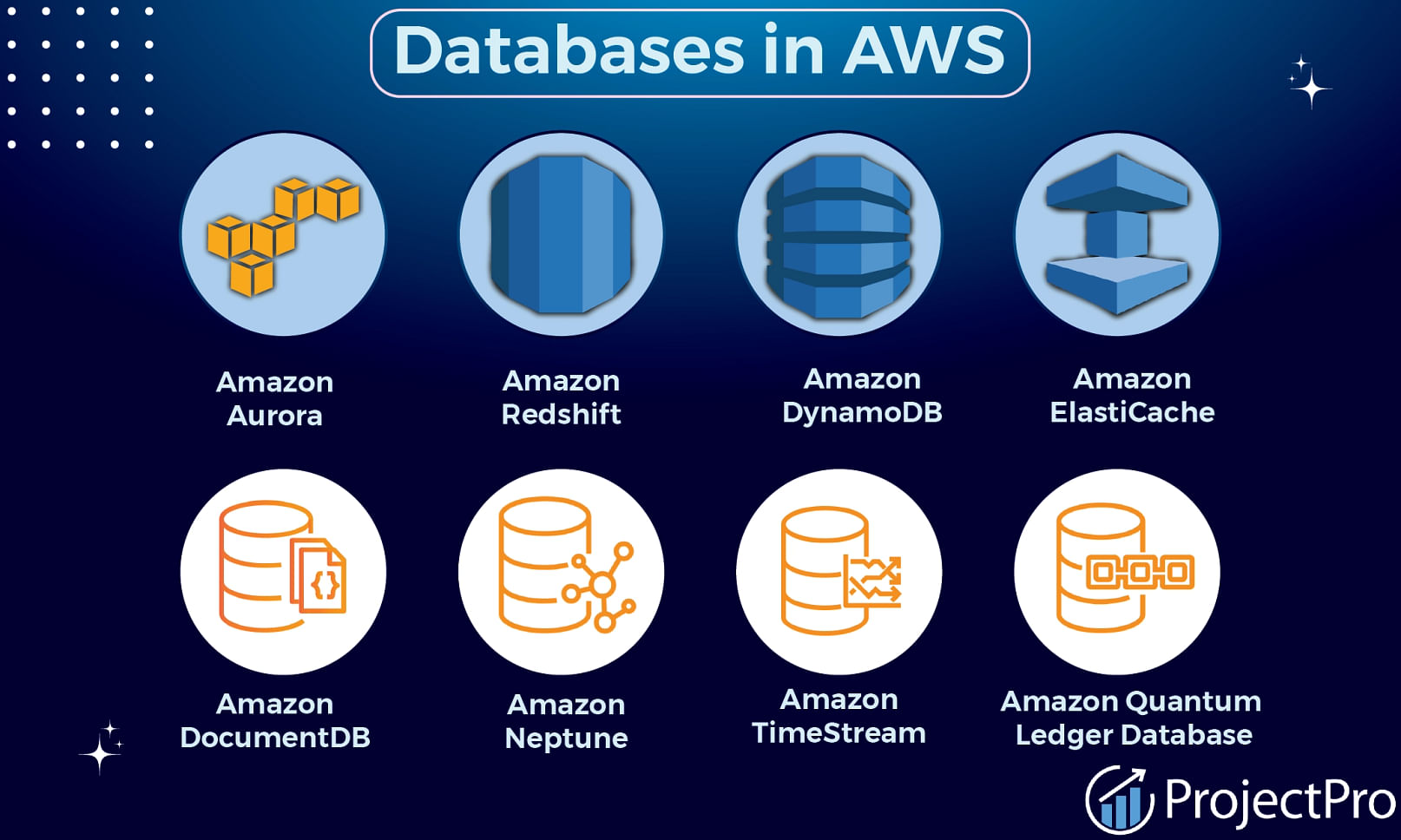Exploring Different AWS Database Services
 Mohmmad Saif
Mohmmad Saif
AWS offers a variety of database services to meet different needs. Here are detailed descriptions of each AWS database service:
Amazon RDS (Relational Database Service)
Engines Supported: Amazon Aurora, MySQL, PostgreSQL, MariaDB, Oracle, SQL Server.
Features:
Automated backups and database snapshots.
Multi-AZ (Availability Zone) deployments for high availability.
Read replicas for improved read performance.
Easy scaling of compute resources and storage.
Integration with AWS IAM for security and Amazon CloudWatch for monitoring.
Amazon Aurora
Compatibility: MySQL and PostgreSQL.
Features:
High performance, up to 5 times faster than standard MySQL and 3 times faster than standard PostgreSQL.
Fault-tolerant, self-healing storage with six-way replication across three AWS Availability Zones.
Automatic failover, backup, and recovery.
Up to 15 low-latency read replicas.
Amazon DynamoDB
Type: NoSQL, key-value, and document database.
Features:
Fully managed with automatic scaling of throughput and storage.
Offers DynamoDB Streams for real-time data processing.
Global tables for multi-region and multi-master replication.
Integrated with AWS Lambda for serverless applications.
Supports fine-grained access control with IAM.
Amazon Redshift
Type: Data warehousing.
Features:
Columnar storage and massively parallel processing (MPP) for fast query performance.
Redshift Spectrum to query data directly from S3 without loading it into Redshift.
Automated backups and snapshots.
Data sharing for real-time analytics.
Integrates with popular BI tools like Tableau, Looker, and Amazon QuickSight.
Amazon ElastiCache
Engines Supported: Redis, Memcached.
Features:
Fully managed in-memory data store and cache.
Supports complex data structures like lists, sets, and sorted sets (for Redis).
Automatic failover, backup, and recovery.
Multi-AZ with automatic failover for Redis.
Clustering for horizontal scaling of Redis.
Amazon Neptune
Type: Graph database.
Features:
Supports property graph model (with Apache TinkerPop Gremlin) and RDF graph model (with SPARQL).
High performance with low latency.
Multi-AZ high availability with up to 15 read replicas.
Automatic backups to Amazon S3.
Built-in security with encryption at rest and in transit.
Amazon DocumentDB (with MongoDB compatibility)
Type: Document database.
Features:
Fully managed with MongoDB 3.6 API compatibility.
Automatic storage scaling.
High availability with multi-AZ deployment.
Continuous backups to Amazon S3.
Integration with AWS services like AWS Lambda, Amazon Kinesis, and Amazon QuickSight.
Amazon Keyspaces (for Apache Cassandra)
Type: NoSQL database.
Features:
Fully managed, serverless, and compatible with Apache Cassandra.
Pay-as-you-go pricing.
Automatic scaling based on application traffic.
Highly available and fault-tolerant with replication across multiple AWS Availability Zones.
Integration with AWS services like IAM for security and CloudWatch for monitoring.
Amazon Timestream
Type: Time series database.
Features:
Optimized for fast ingestion, storage, and querying of time series data.
Automatically stores and organizes data by time intervals.
Continuous data updates and querying with high throughput.
Integrates with AWS IoT Core, Amazon Kinesis, and Amazon QuickSight.
Serverless and scales automatically to handle large volumes of data.
AWS Database Migration Service (DMS)
Type: Database migration.
Features:
Supports both homogeneous (e.g., Oracle to Oracle) and heterogeneous (e.g., Oracle to Amazon Aurora) migrations.
Minimal downtime during migration.
Continuous data replication.
Supports data transformations during migration.
Integrated with AWS Schema Conversion Tool (SCT) for schema conversion between different database engines.
These services offer various features to meet different database needs, including scalability, high availability, performance, security, and integration with other AWS services.
Subscribe to my newsletter
Read articles from Mohmmad Saif directly inside your inbox. Subscribe to the newsletter, and don't miss out.
Written by

Mohmmad Saif
Mohmmad Saif
👋Hello I am Mohd Saif, passionate technology enthusiast currently pursuing a bachelor of Computer application degree. 🎓Education: I am currently pursuing a bachelor of Computer application degree with the focus on coding at Bareilly University my education journey has equipped me with strong foundation in Computer science and I am eager to apply my knowledge to real word challenges. 💡Passion for technology: I have always been deeply passionate about technology and I am particular drawn to devops with AWS. 🚀Skills: 🔹Linux 🔹Shell scripting 🔹Python 🔹Ansible 🔹Docker 🔹Kubernetes 🔹Jenkins CI/CD 🔹Maven 🔹Git and GitHub ✨Future goals: My goal is to facilitate seamless collaboration between development and operations teams, ensuring faster releases and high-quality software. I am a proactive learner, constantly exploring new DevOps trends and practices